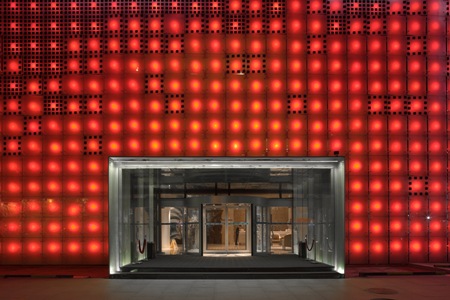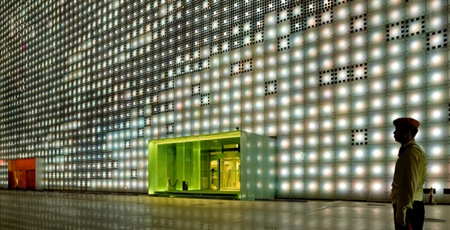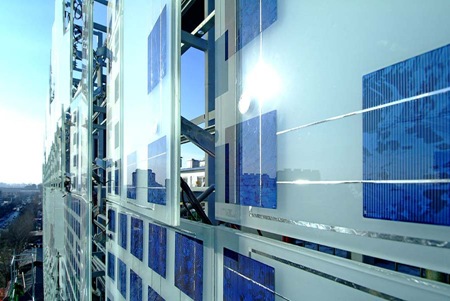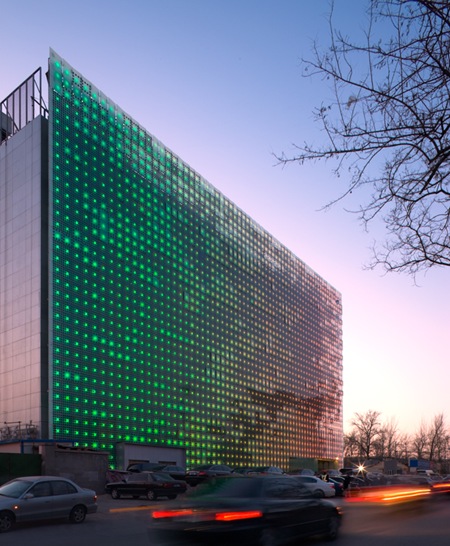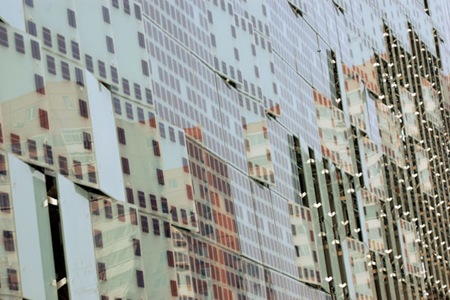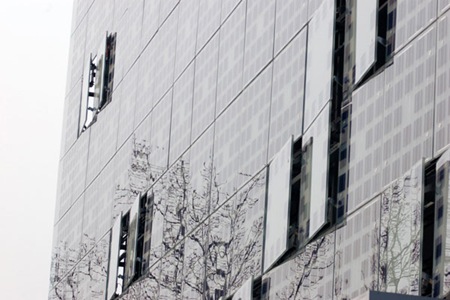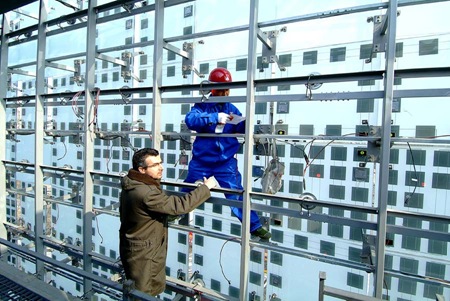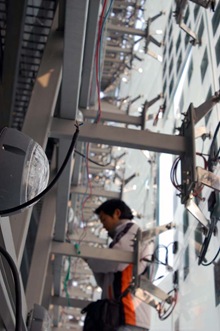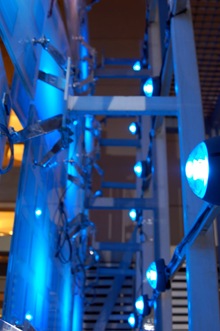1006 Morton Street
Baltimore, MD 21201
410.576.9131 | RW1haWw=
August 27 2008
greenPIX: The Zero Energy Media Wall
Energy in = energy out. Only the format changes. Now that is sustainable.
greenPIX, 'the Zero Energy Media Wall,' uses architecture and technology to absorb, store, amplify, translate, and display data, both natural and manmade, in an organic system that responds dynamically to the local environment. Creative programming adds even more layers to the already rich stream of data being presented and allows passersby to experience the site in terms of space and time through both their own eyes or the minds of the selected artists. Media is displayed on a gigantic screen which uses 2,292 pixels of LED lights and translucent glass. The entire presentation comes with a zero net consuming energy footprint thanks to a glazing-integrated system of perforated photovoltaic cells and a battery storage system. The result is a public art installation that creates awareness of the local environment in both appearance and functionality; sustainability is more than facade deep for greenPIX.
The greenPIX project was designed by Brooklyn based Simone Giostra & Partners Architects in collaboration with ARUP for the Xicui Entertainment Complex in Beijing and is the largest LED display in the world. The project is also the first building facade integrated PV system in China. The building is located in western Beijing close to a number of 2008 Olympic venues. The singular design brief given to Giostra was to 'enliven the building's opaque, boxlike presence and connect it to its environs' all using only one facade.
Media displayed on the large format low-res screen can be presented in both film and still image formats, with the consideration that artists must consider and plan for the implications of jumbo size and low resolution. To account for this, the designers developed a special software package (windows) to allow potential artists to test their creations on a virtual facade before loading it into the media wall. The software shows the facade presentation in a rudimentary 3D cityscape mockup and makes it possible to view the wall from many angles and distances to test the resolution.
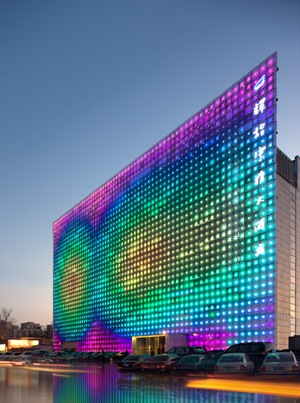 In one example of potential media presentations, artists created an infrared heat map generated solely by locating all the occupants of the building and showing their position in relation to one another. The resulting animation is a dynamic representation of real-time events and begins to address the designer's vision of the wall as a way of linking the building and its occupants to the environs.
In one example of potential media presentations, artists created an infrared heat map generated solely by locating all the occupants of the building and showing their position in relation to one another. The resulting animation is a dynamic representation of real-time events and begins to address the designer's vision of the wall as a way of linking the building and its occupants to the environs.
The entire facade display is roughly 24,000 squaure feet. Each of the 2,292 glass panels comprising the facade has a color changing LED fixture mounted behind it and is a 'pixel' in the large format low-res display. Integrated photovoltaic cells mean that the panels both emit and absorb energy in the form of LED and sun light, thus reinforcing Giostra's vision of 'technological self sufficiency.'
'Seascape', the concept of dynamically changing scene based on both time and vantage point, also played a large role in the design of the facade. Media is the active dynamic element at night. During the daytime however, when sun obscures the LED light, Giostra had to make the passive elements of the facade appear dynamic. He accomplished this by varying opacity and mounting angle (5°) of the glass panels as well as by carefully arranging the integrated PV cells to form a dynamic pattern. The result is a facade that appears to undulate with the rhythm of the environment day and night.
Interestingly, the entire system is a total of seven feet thick including glass panels, structure, power and data infrastructure, LED lighting fixtures and a maintenance access space.
Below is a video interview of designer Simone Giostra discussing the greenPIX project.
For more information please visit the greenPIX website or read ID Magazine's article on Simone Giostra titled "A Gleam in the Eye."
Recent Posts
Reimagining Harborplace to Create Space for Both Private Development and Expanded Public Space » Lawyer's Mall Reconstruction Progress » Confronting the Conventions of Customary Practice » Reconceived Facades: New Roles for Old Buildings » Ivy Bookshop Opens for Business! »
Categories
Yellow Balloon Baltimore » Products + Technology » Industry + Practice » Other » Architecture »
Links
Organizations
- USGBC Baltimore Regional Chapter »
- AIA - American Institute of Architects »
- USGBC »
- The Walters Art Museum »
- Green-e »
- Center for Building Performance and Diagnostics (CMU) »
- Green Globes »
- Prefab Lab (UT) »
- Center for Sustainable Development (UT) »
- Architecture 2030 »
- Bioneers »
- Street Films »
- FreeCycle »
- Chesapeake Bay Foundation »
- Archinect »
- BD Online - The Architects Website »
- National Wildlife Foundation »
- Natural Resources Defense Council »
- Overbrook Foundation »
- Merck Family Foundation »
- Ecology Center »
- New Building Institute »
- Neighborhood Design Center »
- The Leonardo Academy »
- ZigerSnead Architects LLP »
- The Rocky Mountain Institute »
- Urban Habitats »
- ACORE - American Council on Renewable Energy »
- Parks and People Foundation of Baltimore »
- Open Society Institute of Baltimore »
- Natural Capital Institute »
- Passive House US »
- Svanen Miljomark »
- Green Restaurant Association »
- Rocky Mountain Institute »
- Green Exhibits »
- Green Roundtable »
- John Elkington - SustainAbility »
- SustainAbility »
- Building America »
- Endangered Species Program - Fish and Wildlife Service »
- Congress for the New Urbanism »
- Urban Land Institute »
- Cool Roof Rating Council »
- Montgomery County (MD) Public Schools Green Building Program »
- National Institute of Standards and Technology Software »
- Scientific Certification Systems »
- Community Greens »
- CBECS »
- CASE - Center for Architecture Science and Ecology »
Interesting Sites
- The Ecologist »
- Treehugger »
- Grist »
- WIRED »
- Planet Architecture »
- MiljoBloggAktuellt - Environmental News Blog (Swedish »
- Sustainable Design Update »
- Eikongraphia »
- World Architecture News »
- The Cool Hunter »
- Design Center »
- ZEDfactory »
- Architen Landrell Associates Ltd. »
- Environmental Graffiti »
- businessGreen »
- Best Green Blogs Directory »
- Groovy Green »
- EcoGeek »
- Urban Ecology »
- Locus Architecture »
- Urbanite »
- A Daily Dose of Architecture »
- Adaptive Reuse »
- Audacious Ideas »
- Big Green Me »
- NOTCOT »
- Sustainable Baltimore »
- Thoughts on Global Warming »
- Green Maven »
- WorldChanging »
- Go For Change »
- Building Green »
- Home Energy Magazine »
- Home Energy Blog »
- FEMA Map Service- Federal Emergency Management Association »
- Architectural Graphic Standards »
- E-Wire »
- Post Carbon Cities »
- Alt Dot Energy »
- Whole Building Design Guide »
- B'more Green »
- EJP: Environmental Justice Partnership »
- Baltidome »
- OneOffMag »
